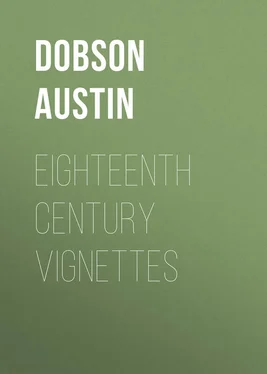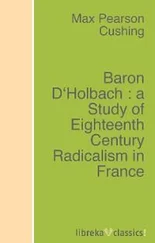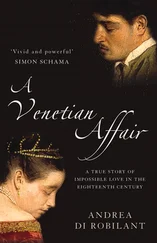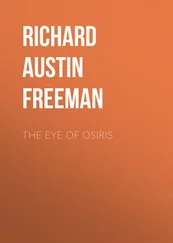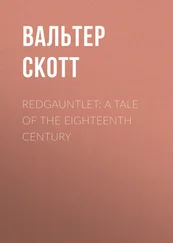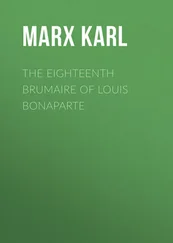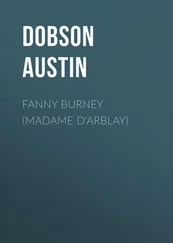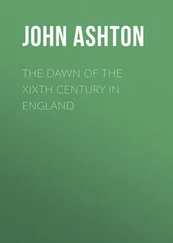Austin Dobson - Eighteenth Century Vignettes
Здесь есть возможность читать онлайн «Austin Dobson - Eighteenth Century Vignettes» — ознакомительный отрывок электронной книги совершенно бесплатно, а после прочтения отрывка купить полную версию. В некоторых случаях можно слушать аудио, скачать через торрент в формате fb2 и присутствует краткое содержание. Жанр: foreign_antique, foreign_prose, на английском языке. Описание произведения, (предисловие) а так же отзывы посетителей доступны на портале библиотеки ЛибКат.
- Название:Eighteenth Century Vignettes
- Автор:
- Жанр:
- Год:неизвестен
- ISBN:нет данных
- Рейтинг книги:5 / 5. Голосов: 1
-
Избранное:Добавить в избранное
- Отзывы:
-
Ваша оценка:
- 100
- 1
- 2
- 3
- 4
- 5
Eighteenth Century Vignettes: краткое содержание, описание и аннотация
Предлагаем к чтению аннотацию, описание, краткое содержание или предисловие (зависит от того, что написал сам автор книги «Eighteenth Century Vignettes»). Если вы не нашли необходимую информацию о книге — напишите в комментариях, мы постараемся отыскать её.
Eighteenth Century Vignettes — читать онлайн ознакомительный отрывок
Ниже представлен текст книги, разбитый по страницам. Система сохранения места последней прочитанной страницы, позволяет с удобством читать онлайн бесплатно книгу «Eighteenth Century Vignettes», без необходимости каждый раз заново искать на чём Вы остановились. Поставьте закладку, и сможете в любой момент перейти на страницу, на которой закончили чтение.
Интервал:
Закладка:
Here, too, is the already mentioned full-length of the founder – a portrait of the masterly qualities and superb colouring of which neither McArdell's mezzotint nor Nutter's stipple gives any adequate idea. Here, again, is one of Hogarth's 'failures,' the 'Moses Brought to Pharaoh's Daughter,' which is not so great a failure after all. Certainly it compares favourably with the 'Finding of Moses' by the professed history-painter, Frank Hayman, which hangs hard by, and is an utterly bald and lifeless production. On the contrary, in Hogarth's picture, the expression in the eyes of the mother, which linger on the child as her hand mechanically receives the money, is one of those touches which make the whole world kin. Among the circular paintings of similar charities is a charming little Gainsborough of the Charterhouse, while the 'Foundling' and 'St. George's Hospital' are from the brush of Richard Wilson.
There is a dignified portrait of Handel by Kneller, which makes one wonder how the caricaturists could ever have distorted him into the 'Charming Brute;' and also a bust by Roubiliac, being the original model for the statues in Westminster Abbey and Old Vauxhall Gardens. There are autographs of Hogarth and Coram and John Wilkes the demagogue; there is a copy of his 'Christmas Stories' presented by the author, Charles Dickens; there is a case in one of the windows full of the queer, forlorn 'marks or tokens' which, in the basket days, were found attached to its helpless inmates – ivory fish, silver coins of Queen Anne or James, scraps of paper with doggerel rhymes, lockets, lottery tickets, and the like. As you pass from the contemplation of these things – a contemplation not without its touch of pathos – you peep into the church, mentally filling the empty benches in the organ loft with the singing faces and pure voices of the childish choristers, and you remember that here Benjamin West painted the altar-piece, and here Laurence Sterne preached. Once more in Guildford Street, you turn instinctively towards another thoroughfare, where lived a later writer who must often have made the pilgrimage you have just accomplished. For at No. 13 Great Coram Street was the home of William Makepeace Thackeray, and from the shadow of the Foundling, in July, 1840, he sent forth his 'Paris Sketch Book.' When, seven years later, he was writing his greatest novel, Captain Coram's Charity still lingered in his memory. It is on the wall of its church that old Mr. Osborne, of 'Vanity Fair' and Russell Square, erects his pompous tablet to his dead son: it is in the same building that, sitting 'in a place whence she could see the head of the boy under his father's tombstone,' poor Emmy feasts her hungry maternal eyes on unconscious little Georgy.
V. 'THE FEMALE QUIXOTE.'
ONE evening in the spring of the year 1751, the famous St. Dunstan, or Devil Tavern, by Temple Bar, – over whose Apollo Chamber you might still read the rhymed 'Welcome' of Ben Jonson; whence Steele had scrawled hasty excuses to 'Prue' in Bury Street; and where Garth and Swift and Addison had often dined together, – was the scene of a remarkable literary celebration. A young married lady, not then so well-known as she afterwards became, had written a novel called the 'Life of Harriot Stuart,' which was either just published or upon the point of issuing from the press. It was her first effort in fiction; and, probably through William Strahan the printer, one of whose employés she married, she had sought and obtained the acquaintance of Samuel Johnson. The great man thought very highly of her abilities: so much so, that he proposed to his colleagues at the Ivy Lane Club (the predecessor of the more illustrious Literary Club) to commemorate the birth of the book by an 'all-night sitting.' Pompous Mr. Hawkins, who tells the story, says that the guests, to the number of near twenty, including Mrs. Lenox (for that was the lady's name), her husband, and a female acquaintance, assembled at the Devil at about eight o'clock in the evening. The supper is characterised as 'elegant,' a prominent feature in it being a 'magnificent hot apple-pye,' which, because, forsooth (the 'forsooth' is Hawkins's), Mrs. Lenox was also a minor poet, her literary foster-father had caused to be stuck with bay-leaves. Besides this, after invoking the Muses by certain rites of his own invention, which should have been impressive, but are not described, Johnson 'encircled her brows' with a crown of laurel specially prepared by himself. These ceremonies completed, the company began to spend the evening 'in pleasant conversation, and harmless mirth, intermingled at different periods with the refreshments of coffee and tea.' But there must have been stronger potations as well, since the narrator, Hawkins, who had a 'raging tooth,' and is therefore excusably inexplicit, speaks of the desertion by some of those present of 'the colours of Bacchus;' and he expressly mentions the fact that Johnson, whose face, at five o'clock, 'shone with meridian splendour,' had confined himself exclusively to lemonade. By daybreak, the 'harmless mirth' was beginning to be intermingled with slumber, from which those who succumbed were only rallied with difficulty by a fresh relay of coffee. At length, when St. Dunstan's Clock was nearing eight, after waiting two hours for an attendant sufficiently wakeful to compile the bill, the company dispersed. Their symposium had been Platonic in its innocence; but to Hawkins, demoralised by toothache, and sanctimonious by temperament, their issue into the morning light of Fleet Street had all the aspect, and something of the remorse of a tardily-terminated debauch. Before he could mentally disinfect himself, he was obliged to take a turn or two in the Temple, and breakfast respectably at a coffee-house.
Although she is now forgotten, Charlotte Lenox, the heroine of these Johnsonian 'high jinks,' was once what Browning would have termed 'a person of importance in her day.' Her father, Colonel James Ramsay, was Lieutenant-Governor of New York. When his daughter was about fifteen, he sent her to England, consigning her to the charge of a relative in this country, who, by the time she reached it, was either dead or mad. Then Colonel Ramsay himself departed this life, and she was left without a protector. Lady Rockingham took her up, receiving her into her household; but an obscure love-affair put an end to their connection; and she subsequently found a fresh patroness in the Duchess of Newcastle. She must also have tried the stage, since Walpole speaks of her as a 'deplorable actress.' Her sheet anchor, however, was literature. In 1747 Paterson published a thin volume of her poems, dedicated to 'the Lady Issabella [sic] Finch,' – a volume in which she certainly 'touched the tender stops of various quills,' since it recalls most of the singers who were popular in her time. There are odes in imitation of Sappho (with one 'p'); there is a pastoral after the manner of Air. Pope; there is 'Envy, a Satire; 5 there is a versification of one of Mr. Addison's 'Spectators.5 To this maiden effort, a few years later, followed the novel above-mentioned, which is supposed to have been more or less autobiographical; then came another novel, 'The Female Quixote;' then 'Shakespeare Illustrated;' then a translation of Sully's 'Memoirs;' and then again more novels, plays, and translations. Mrs. Lenox lived into the present century, supported at the last partly from the Literary Fund, and partly by the Right Hon. George Rose, who befriended her in her latter days, and ultimately, when she died, old and very poor, in Dean's Yard, Westminster, paid the expenses of her burial. She is said – by Mr. Croker, of course – to have been 'plain in her person.' If this were so, she must have been considerably flattered in the portrait by Reynolds which Bartolozzi engraved for Harding's 'Shakespeare.' It is also stated, on the authority of Mrs. Thrale, that, although her books were admired, she herself was disliked. As regards her own sex, this may have been true; but it is dead against the evidence as regards the men. Johnson, for example, openly preferred her before Mrs. Carter, Miss Hannah More, and Miss Burney; and he never, to judge by the references in Boswell's 'Life,' wavered in his allegiance. He wrote the Dedications to 'The Female Quixote' and 'Shakespeare Illustrated;' he helped her materially (as did also Lord Orrery) in her version of Père Brumoy's 'Théâtre des Grecs;' he quoted her in the 'Dictionary;' he drew up, as late as 1775, the 'Proposals' for a complete edition of her works, and he reviewed her repeatedly. What is more, he introduced her to Richardson, by whom, upon the ground of her gifts and her misfortunes (She 'has genius,' and she 'has been unhappy,' said the sentimental little man), she was at once admitted to the inner circle of the devoted listeners at North End and Parson's-Green. Another of her admirers was Fielding, who, in his last book, the 'Journal of a Voyage to Lisbon,' calls her 'the inimitable and shamefully distress'd author of the Female Quixote.' Finally, Goldsmith wrote the epilogue to the unsuccessful comedy of 'The Sister,' which she based in 1769 upon her novel of 'Henrietta,' – an act which is the more creditable on his part because the play belonged to the ranks of that genteel comedy which he detested. A woman who could thus enlist the suffrage and secure the sendee of the four greatest writers of her day must have possessed exceptional powers of attraction, either mental or physical; and this of itself is almost sufficient to account for the lack of a corresponding enthusiasm in her own sex.
Читать дальшеИнтервал:
Закладка:
Похожие книги на «Eighteenth Century Vignettes»
Представляем Вашему вниманию похожие книги на «Eighteenth Century Vignettes» списком для выбора. Мы отобрали схожую по названию и смыслу литературу в надежде предоставить читателям больше вариантов отыскать новые, интересные, ещё непрочитанные произведения.
Обсуждение, отзывы о книге «Eighteenth Century Vignettes» и просто собственные мнения читателей. Оставьте ваши комментарии, напишите, что Вы думаете о произведении, его смысле или главных героях. Укажите что конкретно понравилось, а что нет, и почему Вы так считаете.
